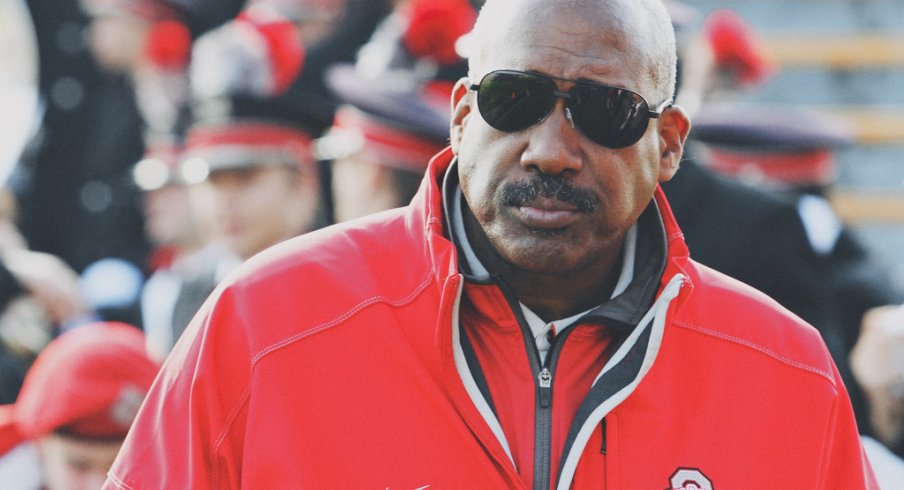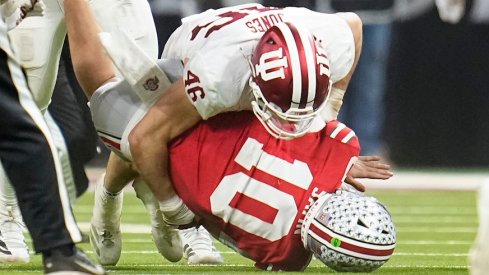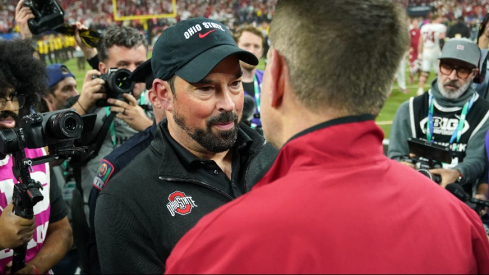The nightmare, as Ohio State athletic director Gene Smith once called it, ended Dec. 20, 2011 — three days short of a year beset with floods of public records requests, apologetic press conferences and, arguably, the biggest blemish in school history.
For an improper benefits scandal that saw five of its football players trade autographed jerseys, rings and other memorabilia for money and tattoos, the NCAA leveled sanctions against the university that still dog and damn it more than three years later.
In the town square of college athletics, Ohio State was publicly flogged by its governing body for its transgressions and how it tried to bury them from percolating to the surface.
But the punishment — which barred the school from the following postseason, slashed scholarships and put it on probation until late next December — was symptomatic of a climate where an aggressive NCAA has turned up how it seeks out and reprimands offenders.
In the coming weeks and months, Ohio State stumbled from the wreckage hobbled, but not maimed. Embarrassed, but not irreversibly humiliated. Unnerved, not undone.
Success on the field, like coach Urban Meyer's 24-2 record in two seasons since taking over the football program, makes the fiasco — which cost the Buckeyes their reputation, a stellar 2010 season and former head coach Jim Tressel his job — feel like an old memory of a faded era.
Winning is novocaine. But it doesn’t fix a systemic problem.
Related
Ohio State's three-year subscription agreement
with jumpfoward (PDF).
Harboring one of the nation’s largest and most-lucrative athletic departments, the school turned to JumpForward, a Chicago-based sports management firm which also provides services for 125 schools including Florida State, Kentucky, UConn, Oregon, Michigan, Notre Dame, USC and Penn State, to help fortify and streamline a rattled compliance department that failed to identify or halt years worth of misconduct infamously and colloquially known as “Tattoo-Gate.”
The school agreed to a three-year, $360,500 agreement with JumpForward in July 2012, according to a contract obtained through a public records request, in an effort of self-flagellation to spare itself from the NCAA’s wrath and prove it was serious about creating a culture of compliance in respect to the intricate, and sometimes silly, web of NCAA bylaws.
As part of the agreement, Ohio State enlisted the help of a feature called the “Social Media Monitoring Solution” one of many compliance services, including coordinating football/basketball recruiting efforts, equipment management, the exchange of complimentary tickets and NCAA rules education.
Of those services, however, perhaps none are more controversial than the practice of formal, software-assisted social network monitoring — which naturally plunges into a bog of free speech and privacy issues. And according to the contract, it seems JumpForward sought access to both public and private accounts, asking Ohio State to provide it with usernames and passwords in addition to a list of student-athletes to be tracked and a list of keywords to be be tracked.
After about a year-and-a-half of using the solution on a “retainer” basis, Ohio State asked JumpForward to start repealing its social media monitoring solution (while retaining other compliance solutions) in October or November of last year, compliance director Doug Archie told Eleven Warriors Thursday.
“We thought we might’ve needed it after that one major infractions case where we thought we may have a duty to monitor everything that they were doing.”
“We thought we might’ve needed it after that one major infractions case where we thought we may have a duty to monitor everything that they were doing,” Archie said.
“We never used it. We had (JumpForward) build it so we would have the capability to do that basically because we thought we had an affirmative duty to check on their accounts all the time.”
Because in the months after the slamming the Buckeyes in late 2011, the NCAA turned its attention toward North Carolina for academic fraud and — among other things — failing to monitor social media for potential rules violations.
Websites like Twitter and Facebook have become transcendent platforms and unlimited forums for communication; the very DNA of social networking lends itself to being a nest for not only exposing more-traditional infractions, but even committing them as the NCAA takes steps in how it should regulate social media.
In the shadow of Tattoo-Gate and under the impression the NCAA would ultimately mandate schools to have an inherent duty to monitor social networking, Ohio State aimed to be proactive in this brave, new and digitally-saturated world. It might also fair to say it didn’t fully understand what it was getting into at the time.
“Over the last several months or whatever, the NCAA clarified that position that institutions do not have an affirmative duty to be looking at a student-athlete’s social media activities with the exception of when they believe that a violation has occurred and that checking their account would help clarify the issue,” Archie said.
That’s true: in a report on March 12, 2012, the NCAA infractions committee found UNC responsible for a bevy of major violations. Included was the failure to monitor social media, but the committee declined to “impose a blanket duty on institutions to monitor social network sites” with the exception of instances which provide probable cause of misconduct.
But considering the NCAA clarified its position on social media monitoring more than two years ago, it raises questions about why it took Ohio State until late last fall to back out of a service it insists hinged on whether the NCAA required schools to do so.
Kevin Deshazo, founder of Oklahoma City-based Fieldhouse Media and social media expert, offered a potential explanation.
“Compliance stuff is so confusing that even people who are in the field, they don’t know the answers to a lot of the questions because you never know how somebody’s going interpret something,” he said.
Instead, Ohio State, like many schools, has created a policy aimed at addressing both the benefits and pitfalls of social media.
“We don’t use JumpForward, nor is there a mandate from the NCAA to monitor social media accounts of our student athletes. We educate but do not comprehensively monitor social media,” athletics spokesman Dan Wallenberg wrote in an email to Eleven Warriors Thursday.
It’s also why, Archie said, Ohio State decided to back off such a particular JumpForward feature rather than keep it in its back pocket.
“We’ve reevaluated that and looked at what our policy allows us to do and said we can accomplish this just through our policy,” Archie said.
“If we need to get something, we can bring the student-athlete in and vet information from them directly.”
For instance: “If we have specific facts to believe that a student-athlete has been involved in a violation and that looking at their social media accounts would help us,” Archie said, “we would then meet with the university’s compliance officer and we meet with our legal affairs officer who works with the athletic department. We’d review the facts and, if they agreed, we would then bring that student-athlete and ask them to turn on their account.”
An excerpt from Ohio State’s Student-Athlete Standards of Conduct and Social Media Policy, obtained through public records, details protocol:
The University may monitor student-athlete public postings on social networks of all kinds, including but not limited to Facebook, Twitter, MySpace, LinkedIn, YouTube, Tumblr, Instagram and Flickr for posting that do not foster such a positive team culture or which otherwise violate team rules, governing athletic rules, University rules or applicable law.
Student athletes should understand that participating in athletics at The Ohio State University is a privilege and not a right. Therefore, student-athletes have no right to expect privacy in what they post on social media.
That’s life in 2014. Isn’t the world already watching anyway?
“I think it’s wise to be monitoring student-athletes’ public information … the rest of the world is monitoring. If you talk to a lot of journalists, talk to a lot of people in the sports industry, they’re following,” Deshazo said.
“Following is essentially monitoring. It’s the same thing. You’re seeing what they’re posting. You don’t want to be the only person to not know what’s happening.”
And, certainly, compliance departments across the nation don’t want to be that person.
It’s why athletic departments have created policies or turned to third parties specializing in advanced social media monitoring like JumpForward, Varsity Monitor or UDiligence.
Schools, like Ohio State, want to protect themselves from something that might not yet be fully understood and from an NCAA which might not fully comprehend the expansive and revolutionary nature of social networking.
“I just think that social media’s something that’s going to be very, very tough to harness,” David Ridpath, an associate professor of sports administration at Ohio University and NCAA compliance expert, said.
"I don’t know if it’s something the NCAA can harness and they’re worried about it.”
“If I’m back in an athletics department, I can certainly see the issues because the NCAA is so backwards and we’re restricting athletes so much, and so much can happen because what we’ve done over the years. We’ve tried to limit every freedom that the athletes have so we prevent violations.”
Social media is the latest front in that war. And as long as the NCAA tries to police the medium, anxiety-ridden schools will do the same to protect themselves.
“Now, here’s something that’s the ultimate freedom for everybody," Ridpath said of social media. "I don’t know if it’s something the NCAA can harness and they’re worried about it.”
Patrick Maks has written for The Lantern and Buckeye Grove. You can find him on Twitter as @maksimuspatrick.


